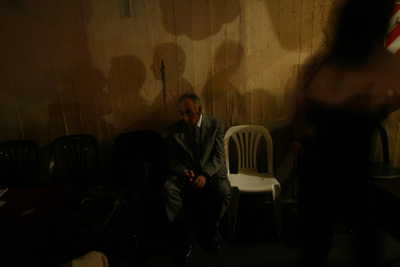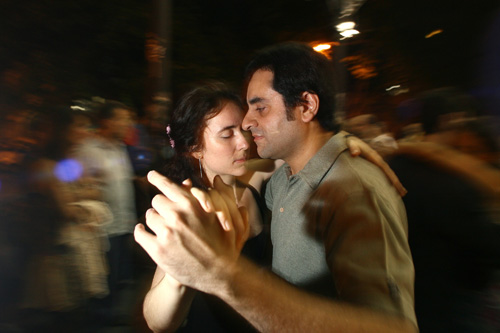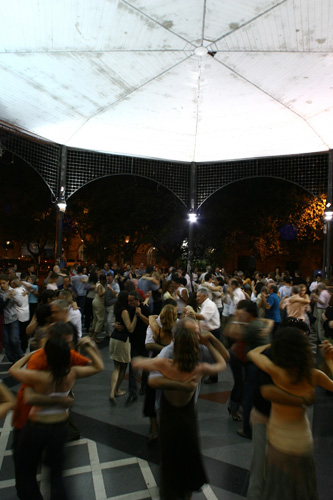
His rancid odor, of midnight smoke soaked in days-old liquor, broods around me. Somehow, intense smells at either end of the spectrum incite the same reaction. Heavy cologne. Sewer water. It’s the same. The man dangles a bottle in his trembling, muddy hands, and tumbles toward me. And his beard — his beard is the bearer of many wandering nights, like this one. I prepare to sidestep him as he approaches me, but the zigzagging couples shish-shinging their feet on an improvised dance floor detour his path.
“El tango te llama,” he growls as the swarm of tightly embracing dancers swallows him. The tango calls you. This tango, in Plaza Dorrego in San Telmo, Buenos Aires, nestled under the sweet daze of dim lights, is carried on the bandoneón’s (a free-reed instrument) cry through the whistling tree leaves, transpiring in the streets where Argentina recovers seven years after its gravest economic crisis.
Maybe it’s the fetor. Maybe it’s a drunkard’s aphorism. Maybe it’s the distorted lament pouring out of an old record player or the newness of my milonga (tango gathering) journey’s first stop, but here under the muted Buenos Aires sky, I feel close to the heart of tango, which perhaps beats more intensely after a testing ordeal. This tango is mortal, with flesh and sweat and stench, too human for the imagination — at least for my glamorous fantasy.
“Tango is a one-way journey,” Romina Lenci cautioned me before my trip. “You don’t come back.” Romina has surrendered to that fate; she has danced tango for more than a decade, and she sees no return. But that just emboldened me. I guess I’m just as intoxicated with the possibilities of tango — with the romanticism of surrendering to a stranger, with the relief of not knowing where I’m going and not caring — as any other rookie. But I have another morbid yearning: I want to confirm the doomed Argentine cycle, epitomized in the back-and-forth, twisting steps of tango. Tango, after all, is the well where Argentine thinkers and corner drunkards look for la argentinidad, the country’s identity. I wonder how, through all the nation’s upheavals, Argentina’s signature music and dance resonate in its people.
I throw a furtive look at Guillermo Segura, who, in utter contrast with the drunkard, stands stoically beside me, his tall, clean-cut silhouette squeezing through the mountains of shadows that stand shoulder to shoulder on the dusty wooden dance floor. Languid feet fly like birds over the peaks and valleys. Guillermo, eyes half-closed, remains silent, but occasionally blurts out little snippets about tango, about his life.
He started dancing tango after he separated from his partner.
He despises the old-fashioned tango rituals.
He’s just waiting for Argentina’s next crisis — economic or political.

A crisis every 10 years
Tonight, nothing seems to surprise Guillermo. Not this decaying lushness, not all the hype about his country’s miraculous recovery. In early 2002, the value of the peso dropped 75 percent. Five presidents took office in 10 days. Half the country fell below the poverty line. Five years later — an outstanding amount of time to come out of the mess that was Argentina — the new president, Cristina Fernández de Kirchner, seems to continue Argentina’s new chapter, which was started with her husband, Néstor Kirchner. But even this new chapter is tainted by doubt (reports about misleading inflation numbers emerge) and pessimism (economic gains still haven’t solved pivotal social issues).
And to that, Guillermo seems to stand unfazed; he submerges himself in tango and waits for the next low. “Every 10 years there’s a crisis,” he says. It’s a learned line that almost every Argentine disguises as a self-sabotaging joke. “It’s mathematical,” he grins as he counts in his head — just a couple more years. I wonder if he could smell the storm coming: In March, Argentina’s farmers went on strike — four months into the new president’s term — leaving Argentina’s stores and pantries empty.
To survive their tribulation, many Argentines are pinning their hopes on tourism to bring the country’s economy back to health. Tourism, an industry that boomed after the recession, is Argentina’s third source of revenue, bringing in more than $4 billion dollars in 2007. And in times of crisis, improvisation — as always — came in handy; the tango scene was reinvigorated with an increasing number of lessons and clubs. From three-figure tango packages at the Buenos Aires Hilton, to shows in La Ventana and Madero Tango, to low-key, low-budget classes in hostels such as Sandanzas, tango is the well Argentina is drawing from for its selling essence as well.
Its people, however, can’t help but cloud those hopeful signs with skepticism.
Here, in the half-lit Plaza Dorrego, in a culture of muffled extremes and controlled debauchery, nothing appears to have changed, yet everything has happened. Signs of the nation’s revival are clear though fragile, as they lie alongside the scars: graffiti decrying corruption and calling for presidents to step down scratch historic buildings; a beautiful boy huddling in a corner, eyes shut, lost.
Avenida Corrientes: a twilight zone
Having seen enough, Guillermo tries to figure out our way out of the labyrinthine cobblestone streets of the tango barrio (neighborhood).
“San Telmo disconcerts me,” he mutters as we dodge the cracks on the impossibly narrow sidewalks. We move swiftly, breathe in the spring’s silvery air, leave block after block behind us, cross over spilled garbage, pass the tumultuous Plaza de Mayo, where pigeons flock during the afternoon. Their flight, a mirage of lazy days, deflates the brewing intensity of innumerable protests. Then, the ever-expanding Avenida Corrientes, that decadent boulevard that harbors the porteño* sensibility and broods tango, unfolds before us.
It is around 10 o’clock; the streets are waking up for the famous Buenos Aires nightlife. There is no better stage than Corrientes to showcase its contradictions: the glitzy theater plays and hectic nocturnal revelry amid the constant rummaging of cartoneros (collectors of cartons) among the garbage. How true that old tango song, “Tristezas de la calle Corrientes,” sounds now:
¡Qué triste palidez tienen tus luces!
¡Tus letreros sueñan cruces!
¡Tus afiches carcajadas de cartón!
What sad paleness your lights bear!
Your billboards dream of crosses!
Your posters are cardboard laughter!
It’s like a twilight zone, la argetinidad and the blinding lights in an unusually deserted Corrientes. The street widens, and on its concrete horizon rests the translucent Obelisco, defiantly piercing the blue night. Guillermo is warming up to me now and is more talkative. So I ask this question, which I figure these days is as normal as asking how someone is: “How did you survive the crisis?
With a nonchalant tone, he said he was OK.
A physicist at an oil company. OK.
Did he want to leave, like the 300,000 who fled the recession?
“I like having a place to belong to.”
Buenos Aires is his home. And that’s that.
Tango: resignation and rebellion
We leave Corrientes and descend into the dim grotto of the subte, the metro. Our next milonga is several stations away. Encased in this metallic worm, blank stares and lifeless expressions seem to fade in the fluorescent daze as time creeps by with each lulling revolution. A slender Asian girl sits across from us, her black-tight legs crossed, her hair entangled in a bun, and in her lap, a tango-shoes bag. I can’t wait to get out.
As the train makes a stumping stop, Guillermo points out that just a few blocks away are the villas miseria (slums), which ironically are what the most luxurious buildings look out over. After the crisis, many moved into shantytowns and have not come out.
He falls silent, again.
I wonder if Guillermo’s deadpan expression and sporadic blasts of laughter are a disguise for that ingrained melancholy so well known in tango, an amalgam of resignation and rebellion to a condemned cycle: 1966 — rise of military dictatorship; 1976 — dirty war; 1989 — economy melts down; 2002 — half the population falls below the poverty line after years of illusory bonanza.
“Every 10 years there’s a crisis,” I remind myself; I’ve heard it so many times.
That roller coaster of a history resembles the ocho (figure eight) that milongueros (tango dancers) draw on the dance floor. With each dip it confirms what writer Ezequiel Martínez Estrada once said: “[Tango is] the dance of pessimism … the dance of the monotonous great valleys, of an overwhelmed race who, enslaved, walk these valleys endlessly, aimlessly, in the eternity of its present that repeats itself. The melancholy comes from that repetition.”
La Glorieta: scene of contradictions
Ten blocks and a subte ride later, we arrive at La Glorieta, a pavilion in Barrancas de Belgrano, one of the well-off parts of town. La Glorieta is a milonga hot spot during summer and spring. On this late October night, it’s packed. A nerdy-looking guy twirls his partner, the girl from the metro, counterclockwise. She does the caminado (walking) with her eyes closed and the side of her head glued to her partner’s.
I look around. It’s fair ground: all ages, nationalities, and skill levels. Amateurs, who stay in the middle, to veteran tangueros, who loop the outskirts of the round pavilion — and all with baggage, with something they need to forget.
“The milonga is a place that gathers very special people, lonely people, whose heads are a quilombo [mess],” says Romina, whose ancestors have danced tango for as far as she can remember. “Some people go to therapy, others go to milongas.”
In the months after the latest crisis, Romina noticed differences in the milonga scene: some perfunctory, some profound. To dance, people didn’t fix up as nicely as before. But they would go to the milonga after a cacerolazo, where, banging pots and pans, they would protest against the government.
La Glorieta is getting crowded. I huddle in a corner, still insecure of my tango skills and still rusty with the do-you-want-to-dance rituals. Guillermo has already done a few rounds. From one end, he spots me, and with an energy I haven’t seen before, he walks toward me grinning and introduces me to Regina Alleman. Poised as a delicate tulip, Regina talks with that Argentine cadence and glides her slim frame in the arms of a milonguero. I think Regina is porteña* until she says she moved here from Switzerland two years ago, following the call of tango.
It was the paradigm that attracted her. “The city, like tango, has this contradiction: joy and sadness, people that are open and people who are mistrustful [living in the same place and time].” Though she arrived three years after the economic meltdown, Regina can still perceive the fear in people. “However, [the crisis] did yield something positive: People live in the moment.”
In this moment, beads of sweat glide down foreheads, heels and sneakers mingle in a poetry of movement. It’s been almost an hour since I arrived at La Glorieta, and the crowd is overflowing. The music — a mix of old and new tango — fills the plaza: Los Reyes del Tango, Juan D’Arienzo, Orquesta Fernández Fierro, Osvaldo Pugliese, and an occasional batch of salsa, rock, or swing between rounds of tango.
My eyes sweep through the swarm of milongueros, and suddenly they meet with the stare of a woman leaning on the fence. Señora Ramona, a 50-something porteña who lives nearby, frequents La Glorieta, but not as often as before, she tells me. She fears for her safety; the streets of Buenos Aires have roughened up. I ask for her last name. She declines. And then she hugs me, tells me to take care, and walks away. I grin as I begin to savor the charm of tango’s contradiction.
“Yo soy el tango de ayer…” I’m the tango of yesteryear, an old man sings.
The last note dies away, but lingers in memory. The crowd spreads to all directions, and I reunite with Guillermo at the foot of the stairs where a line of girls are taking off their heels and changing into tennis shoes. Sandra, a petit brunette with a quick smile, packs up her tango shoes and pulls out a map from her bag. We join her and agree to go to Porteño y Bailarín, in Riobamba.
The night is young.
A sad thought danced
On the meandering route 29 bus, our newly formed trio navigates the clogged veins of a proud, bruised Buenos Aires, the city of Jorge Luis Borges, of “the uncertain yesterday and different today,” the home of 11 million souls. A bump, a turn, a stop. I begin to feel Buenos Aires’ beat. Through the fingerprint-stained window, I see patches of light and darkness; European-style buildings and unassuming houses; shadows swallowed by the light of a night lived as day.
Porteño y Bailarín bears a more formal demeanor than La Glorieta. Guillermo is not fond of this smoky place: He doesn’t like the old rituals, like the cabeceo (when a man asks a woman to dance with a head movement), that are still practiced in traditional milongas, and the two dance floors — one for veterans (all dressed in dark attires, sitting stoically at minimalist tables) and another for the younger, rookie crowd, squeezed in the back.
Sweet cologne, aired wine, used air. We make our way through the hall. I’m smelling smelled odors; I’m seeing seen scenes. A few heads turn, murmurs tickle our ears as we scurry among tables. I’m walking walked paths, of immigrants, of prostitutes, of taxi drivers, of pathologists, of seized memories. In the back, we find a spot. Is this la argentinidad? Squeezed between social lines, among the cracks of a tired valley, walked over time and again? Reinventing, reducing, resuming the journey to a known end?
Extremes, in the end, meet at the same place.
“Do you tango?” a man asks me from his corner, skipping the cabeceo ritual, breaking conventions.
“No,” I say from my end. I’m tired. I’m afraid. I’m not ready to plunge into the endless walk of tango. Not tonight.
But Guillermo, despite his reservations about the place, lunges into a tango with Sandra. It’s better to dance than to stand still.
“Tango is a sad thought you dance,” Enrique Santos Discépolo once said. The venerated tango lyricist’s simple definition is in each step Guillermo propels and Sandra anchors — two shadows merged in their solitude, furling, breaking the monotony of the green walls that shelter their ephemeral escape from reality.
I silently count the number of years to the next crisis. Five or four. That omen invariably hangs over every Argentine’s head. But this night is old and tango is alive in Buenos Aires.
Guillermo walks me to a corner and helps me grab a cab back to my hostel. We promise to see each other the next day; we’d never fulfill it. I hop in the taxi. The city shines through the cab’s window. The humid streets emanate a heavy, fishy mist, and once in a while I’d see dead pigeons on the sidewalks.
* Porteño/portena refer to an inhabitant native to Buenos Aires.

- Follow us on Twitter: @inthefray
- Comment on stories or like us on Facebook
- Subscribe to our free email newsletter
- Send us your writing, photography, or artwork
- Republish our Creative Commons-licensed content

